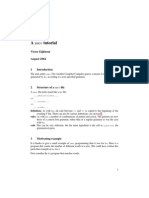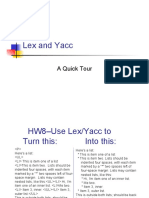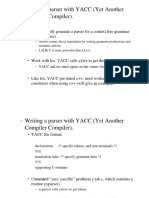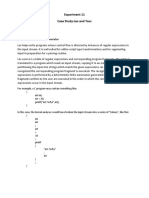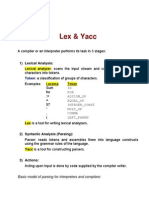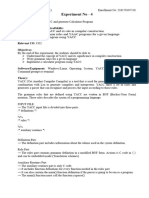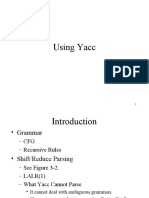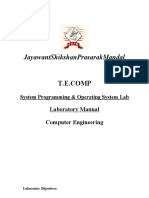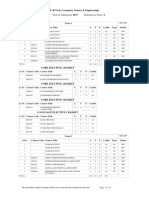0% found this document useful (0 votes)
78 views10 pagesExample (Contd.) : String: "Id + $"
The document describes an example of a LALR parser generator called yacc. Yacc takes a grammar specification as input and generates C code for an LALR parser. It divides the input into definitions, rules, and subroutines sections. The definitions section declares token types, the rules section contains the grammar rules, and the subroutines section holds user-defined subroutines. Yacc resolves shift/reduce and reduce/reduce conflicts in the grammar. Syntax directed translation can manipulate attributes on the parse tree to perform operations like generating a postfix expression from an infix input string.
Uploaded by
Sathya PriyaCopyright
© © All Rights Reserved
We take content rights seriously. If you suspect this is your content, claim it here.
Available Formats
Download as PDF, TXT or read online on Scribd
0% found this document useful (0 votes)
78 views10 pagesExample (Contd.) : String: "Id + $"
The document describes an example of a LALR parser generator called yacc. Yacc takes a grammar specification as input and generates C code for an LALR parser. It divides the input into definitions, rules, and subroutines sections. The definitions section declares token types, the rules section contains the grammar rules, and the subroutines section holds user-defined subroutines. Yacc resolves shift/reduce and reduce/reduce conflicts in the grammar. Syntax directed translation can manipulate attributes on the parse tree to perform operations like generating a postfix expression from an infix input string.
Uploaded by
Sathya PriyaCopyright
© © All Rights Reserved
We take content rights seriously. If you suspect this is your content, claim it here.
Available Formats
Download as PDF, TXT or read online on Scribd
/ 10







